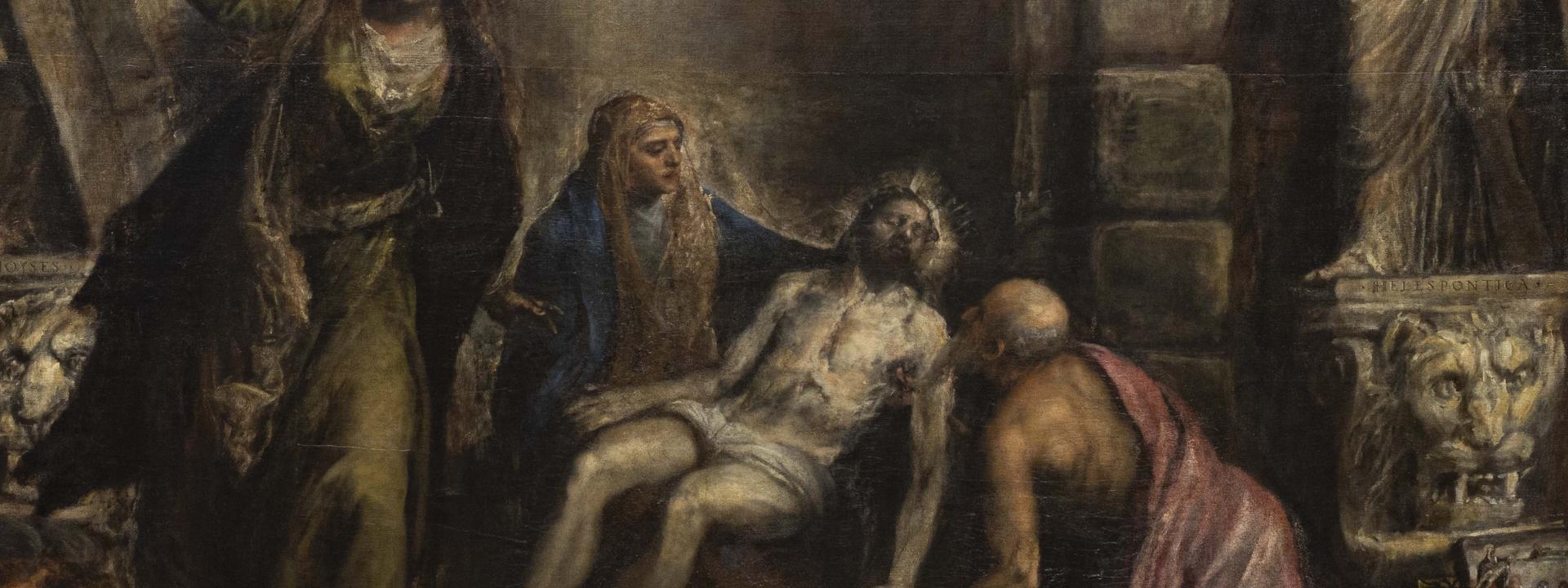Titian executed this painting for the Christ chapel in the church of the Frari in exchange for the church’s concession that he could be buried there. When the agreement fell through, the work was taken back to his workshop where, presumably around the first half of the seventeenth century, it found a new home in the church of Sant’Angelo in Venice before being acquired by the Gallerie. The meaning of the work, conceived as a burial work, is centred on the theme of death, the eucharistic sacrifice, and the Resurrection, which many symbolic elements allude to. In the apse’s mosaicked basin, a pellican is shown pecking at its breast in order to feed its young with its own blood, a symbol of Christ’s sacrifice and resurrection. Above the two pedestals with lion’s head we have the statues of Moses (on the left) and the Hellespontine Sibyl (on the right), whose names are inscribed on the pedestals. Within her aedicule, or niche, stylistically inspired by the architecture of Giulio Romano and Sebastiano Serlio, the Virgin is holding her son’s lifeless body while Mary Magdalene, distraught by the tragic event, screams her pain for all the world to hear. Like Michelangelo, Titian represents himself in the Pietà intended for his own grave: he is the old man prostrate before the Virgin, traditionally identified with Nicodemus or Joseph of Arimathea. The technique is typical of Titian’s final works and is characterised by dark colours applied with thick, fast brushstrokes, flickering with light. In 1576, as the plague raged through the city, the artist transformed the work into an enormous votive offering against the epidemic, as can be seen from the small panel to the right of the composition. Titian died on 27 August of that same year, and the work was completed by Palma Giovane, as per the script in the lower central section: “Quod Titianus inchoatum reliquit / Palma reventer absolvit deoq dicavit opus” (What Titian left unfinished, Palma with reverence completed and dedicated the work to God”). Palma’s contribution, however, was limited to the torch-bearing angel (painted over a preceding putto Titian had left unfinished), the script, and a few touches to hide various joints.
- Visit
- What's on
- On-line collections
- SEATS
- Exhibitions
- EDUCATION PROGRAMMES
- Online Activities
- Artworks not on display
- SPACES AND IMAGES CONCESSIONS
- SUPPORT US
-
TRANSPARENT ADMINISTRATION
- GENERAL PROVISIONS
- ORGANISATION
- CONSULTANTS AND COLLABORATORS
- STAFF
- PERFORMANCE
- Bandi e gare
- CONTRACTS
- Determine
- PROVVEDIMENTI
- BALANCE SHEETS
- GRANTS, CONTRIBUTIONS, SUBSIDIES, ECONOMIC ADVANTAGES
- ADMINISTRATIVE PAYMENTS
- LEGAL PROCEDURES
- ADMINISTRATIVE SUPERVISION AND EVALUATION
- ACCESSO CIVICO
- SERVICES PROVIDED
- OTHER CONTENTS
- CREDITS
- CONTACT
- English
- italiano



